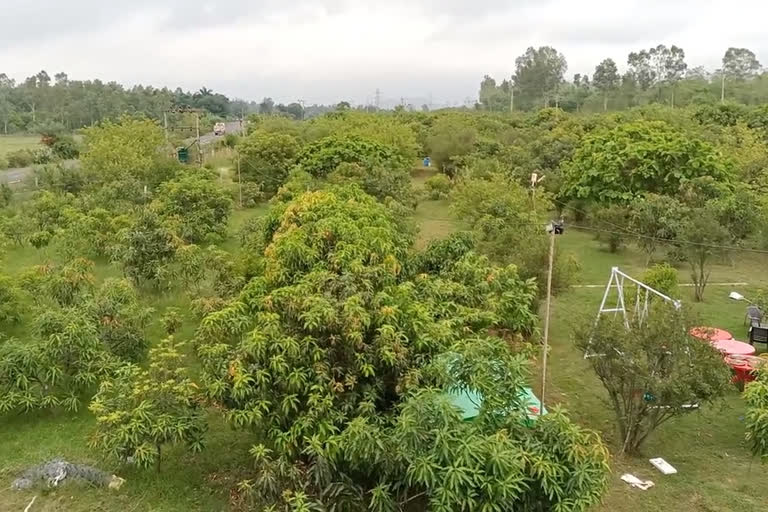Jabalpur (Madhya Pradesh): People visiting the mango orchard are allowed to take selfies, but told not to touch the fruit because it will affect the yield. These succulent and high-energy giving mango varieties are grown under the watchful eyes of 12 foreign breed dogs and three desi canines, and four workers provide security to the mango grove round-the-lock. The CCTV cameras have also been installed for protecting the King of Fruits.
The mango grove Shri Mahakaleshwar Hybrid Farmhouse is situated in the Nanakheda Hinota area about 25 km away from Jabalpur district headquarters. The owner of the orchard is Sankalp Singh Parihar. Several foreign species of mangoes, including indigenous ones, have been planted in the horticulture garden. Jumbo Green mango also known as Talala Gir Kesar, Kesar Badam mango from Nepal, Ivory mango of China, Mangifera Tommy Atkins grown in Florida, the United States, which is also known as Black mango are some of the attractions of the orchard. Apart from these varieties of mangoes, Miyazaki, which is also called Japanese eggplant, Taiyo nee Tamago also known as Egg of Sun, is one of the costliest mangoes in the world. The orchard has eight overseas varieties besides 20 Indian species of mangoes.
Speaking about Miyazaki the costliest mango in the world, the owner of the mango plantation, Sankalp Singh said, "Miyazaki's cost in Indian currency is Rs 2.70 lakh. This variety of mango derived its name from Miyazaki province in Japan where it is grown. Now, the Miyazaki mango is cultivated at several places in the country."
Read: Purple colored 'Tommy Atkins' mango hit among diabetics
Explaining the importance of another foreign species, Mangifera Tommy Atkins also called Black mango, Sankalp Singh said, "We are producing Florida variety in our orchard. The Black mango is healthy for diabetics because its consumption doesn't lead to a rise in blood sugar levels. Though the mango carries a deep purple colour and the pulp has red colour. These mangoes contain less glucose and taste-wise it is acidic. Hence, it is ideal for diabetic patients."
Talking about another 'heavyweight' mango cultivated in China, Sankalp Singh said, "Ivory mangoes are also grown in our orchard. These species of mangoes weigh around two to three kilograms and sometimes they could weigh up to four kilograms also and has a length ranging from one to one and a half feet. The flowering in the plant starts in January month and the fruit ripens by the end of June. Even the kernels (inner hard substance) of these mangoes weigh around 100 to 250 grams."



